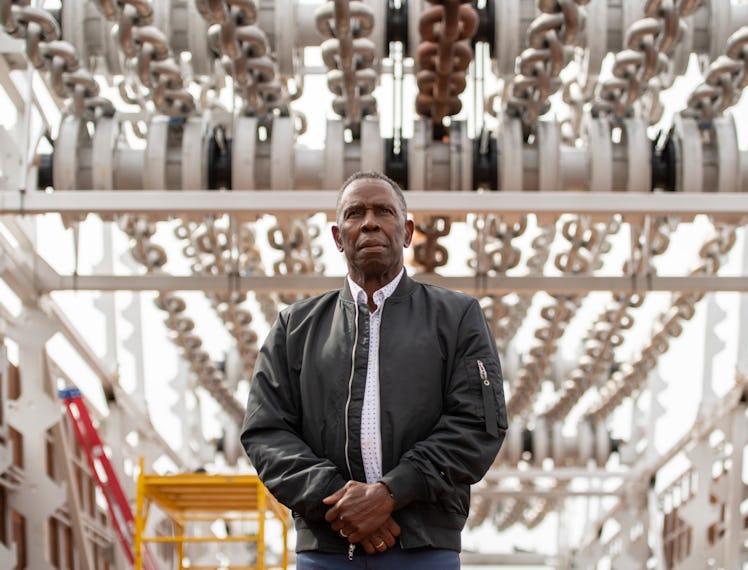Charles Gaines Reframes American History
This month, the conceptual artist unveils his first public installation in New York City.

Charles Gaines may be best known for his drawings—which, over his 50-year career as one of the foremost conceptual artists of the 21st century, have depicted faces, trees, and the continent of Africa traced onto a grid—but his next project couldn’t exist further from the page. Gaines, whose groundbreaking works have been the subject of over 70 solo shows and several hundred group exhibitions since 1972, will unveil his first public artwork ever on Governors Island on October 15. Titled Moving Chains, it is an installation of the grandest order: a 100-foot-long sculpture that looks something like a shipping container, but is meant to evoke the hull of a ship. The piece is a rectangular structure made of wood that viewers can walk through, simulates the loud and intense feeling of being trapped in the belly of such a vessel, thanks to nine rows of enormous chain links that churn over the top of the sculpture.
Gaines, who is now 78 years old, has spent the last half-century creating works that call into question subjectivity, the validity of the imagination, and how race affects lived experience. In conversation, the artist is philosophical, roving, and expansive, covering concepts that are difficult to wrap your head around until you’ve mulled them over for a bit. This kind of multilayered thinking, moored in both the abstract and the tangible, is what makes Moving Chains such a fascinating piece. The sculpture represents three linked themes: American capitalism, born on the backs of enslaved African people; Manifest Destiny and colonial imperialism, and racism. Moving Chains means to shine a light specifically upon how these three ideas are interwoven and, indeed, dependent upon one another—and how this foundational financial system continues to shape American life today.
A rendering of Moving Chains, as it will be displayed on the shore of Governors Island.
“Nobody actually taught in American schools the idea that slavery was a product of imperial and colonial practice,” Gaines tells me, seated at a café inside the hotel in Manhattan where he’s staying (the artist is based in Los Angeles; he works as a professor at CalArts). “It’s clear to a crazy person that they’re connected, but it wasn’t taught that way. I think the reason was because of a certain idealism they wanted to attach to these histories and these principles, to ennoble them and to suppress the violence. That was necessary in order to keep it going.”
It’s fitting for Gaines to create an artwork that’s based on the idea of systems—he practically wrote the book on systems in art. Back in the 1970s, Gaines’s work took a series of alphanumeric systems and substituted them for the imagination; instead of dreaming up a face that he would then draw, Gaines followed a grid based on letters and numbers to create art. Moving Chains is a continuation of this language work, he says. “My interest in this whole project is to put together this critique of American history and culture through these three subjects, which I think have been deceptively separated,” he continues. “I’m trying to expose their linkage, which reveals this really problematic underlying story that brought forward the violence that was necessary to build the United States.”
Moving Chains in the middle of its installation on Governors Island.
Gaines’s predilection for dense theoretical subject matter attracted critique from the art world in the 1970s and 1980s. To hear Gaines tell it, he feels his career has been marked by resistance against him, his ideas, and his being a Black man. “Art is just rough,” he adds. “It’s a tough life if you reach a level of success. So I’m not expecting to be welcomed by a brass band or anything, but the art world in the 1960s and 1970s was old-school racist—a lot of Black artists weren’t getting properly recognized, and part of that had to do with the fact that their interests weren’t thought to be as sophisticated as what white artists were doing.
“Why, when I was showing at the premiere galleries at the time, couldn’t I get any writers or curators interested in advancing my work? In the galleries where I was being shown, I was considered a backroom artist. And even when I got the front space, I don’t think I got the full force of the gallery behind it.”
Still, Gaines has steadily put out work despite any roadblocks—systemic or otherwise. Perhaps his tenacity can be chalked up to his prolific mind, or his insatiable curiosity about the world around him, which he views more like a Nietzsche or a Socrates than a Monet or a Matisse. Whatever it is, the artist remains at the forefront; this year, in fact, he will receive honors from Creative Time (the arts nonprofit which commissioned Moving Chains, along with Governors Island Arts and Times Square Arts) at its annual gala in December.
“Meanwhile, I also have this general philosophy that artists shouldn’t complain about the fact that art is hard,” he says.
Charles Gaines at the Moving Chains install site on Governors Island.